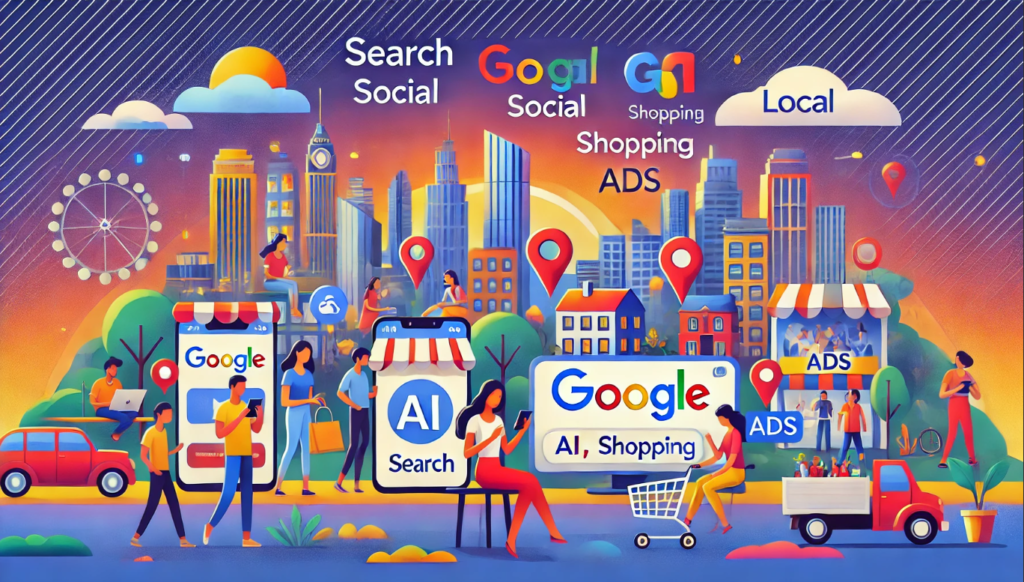Google has been at the forefront of innovation when it comes to its search engine capabilities. Over the years, it has continually evolved to cater to changing consumer needs, interests, and trends. In this article, we will delve into how Google is seamlessly blending search, social, local, shopping, AI, and ads to create a more engaging user experience.
The Shift Towards Social Features in Search
In an era where mobile devices dominate internet access, Google recognizes the need to adapt. The statistics reveal that over 59% of visitors to Google.com use mobile devices. Additionally, social networks are outpacing search engines in terms of user engagement. This shift in user behavior has prompted Google to incorporate social features into its search results.

Social Media Features in Google Search
Google’s incorporation of social media features is driven by the desire to maintain user engagement. Social networks like Facebook, Instagram, and TikTok are known for keeping visitors highly engaged. Not only that, but they also offer a wide array of ad formats for advertisers to leverage in their marketing efforts.
In response to the growing demand for social features, Google has embarked on integrating social elements into its search results. Users can now encounter discussions, social posts, videos, and generative AI content within the search results.
AI-Powered Search and Google's Experimentation
In addition to the social aspect, there is a growing interest in AI-powered search. According to a survey conducted in the United States, there is a notable interest in AI-driven search capabilities.
Google has also expressed its intention to experiment with ads in its Search Generative Experience (SGE), aligning with Bing’s AI copilot for search. This move by Google aims to provide users with more sources for research and informed decision-making.
Moreover, the integration of social and AI features facilitates the collection of user engagement data, which will be valuable for first-party advertising data, especially as third-party cookies are phased out.
Exploring Google's New Features
Let’s delve into some of the latest features that Google has introduced in its search ecosystem.
Personalized Google Discover Feed
When you open the Google app, you’ll find your personalized Google Discover feed. This feed is akin to social newsfeeds, featuring recent headlines, videos, trending topics, and information about topics you follow. As you scroll through this feed, you’ll also come across ads from Discovery campaigns, offering new opportunities for advertisers to reach their target audience.
Web Stories With Ads
Google has integrated web stories throughout the Discover feed, a feature reminiscent of social networks like Instagram. These stories keep users engaged within the Google app and provide additional opportunities for displaying ads.
Shopping Results In The Discover Feed
Google’s Discover feed also features shopping results, showcasing products and pulling in items mentioned in articles. This opens up the possibility for shopping ads to be seamlessly incorporated into the feed.
Social Media Videos & YouTube Shorts
Videos from YouTube, including Shorts, appear in the Discover feed. These videos offer various ad formats, providing marketers with additional channels for reaching their audience.
Notes With AI-Generated Images In SERPs
Google’s experimental feature called Notes allows users to leave comments in search engine results pages (SERPs). This feature introduces a new dimension for user engagement, with the potential for sponsored notes in the future.
The Role of Social Signals
Likes, saves, shares, and Notes are not only indicators of user engagement but could also influence rankings within the Discover feed. Similar to social networks, these engagement signals may play a pivotal role in determining the visibility of content.
Google Profiles With Social Links
When users create Notes, they appear on their Google profiles. Users can edit their profiles to include links to other social profiles. This interconnection between Notes and profiles enhances user engagement and interaction.
Follow This Search
Google allows users to follow searches for keywords, brands, products, and topics. This feature ensures that users stay updated on topics of interest and reinforces the integration of social elements in the user experience.
SGE While Browsing
The Search Generative Experience (SGE) while browsing enhances the user’s search experience by providing summaries, additional information, and more search results while they are browsing a website. This feature adds depth to the search experience, making it more informative and engaging.
Local Search, SGE, And Social Posts
Local search results now include a combination of local pack results, generative AI content, and links to social networks, videos, and discussion forums. This integration of social elements enhances the local search experience and complements Google Maps’ social features.
Perspectives In Search
Google’s search filters, known as Perspectives, include results from various sources such as blogs, news sites, and social platforms like Instagram, Medium, Reddit, StackOverflow, TikTok, and YouTube. This feature highlights the importance of optimizing content not only on websites but also on forums, social profiles, and individual posts for improved discoverability.
Discussions And Forums In SERPs
Reddit’s presence in search engine results pages (SERPs) adds an extra layer of conversation and perspective to search results. This feature enriches the user experience by providing diverse viewpoints.
User Feedback For Discover Results
Google actively seeks user feedback about ads, stories, news items, and YouTube videos in the Discover feed. User sentiment from these surveys can influence content visibility in the feed, contributing to an improved user experience.
Conclusion: Embracing an Omnichannel Approach
Google’s integration of search, social elements, shopping, video content, local results, AI, and ads signifies a paradigm shift in digital marketing. Marketers must adapt to this evolving landscape by adopting omnichannel marketing strategies. This entails optimizing content for mobile users, actively engaging with social features in search results, and staying attuned to emerging trends. By doing so, marketers can effectively reach and engage with their target audiences in this dynamic digital ecosystem.



